Pulmonale - Study guides, Class notes & Summaries
Looking for the best study guides, study notes and summaries about Pulmonale? On this page you'll find 1323 study documents about Pulmonale.
Page 4 out of 1.323 results
Sort by
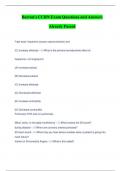
-
Barron's CCRN Exam Questions and Answers Already Passed
- Exam (elaborations) • 21 pages • 2023
- Available in package deal
-
- $12.49
- + learn more
"high dose" dopamine causes vasoconstriction and (C) Increase afterload - What is the primary hemodynamic effect of: Dopamine >10 mcg/kg/min (A) Increase preload (B) Decrease preload (C) Increase afterload (D) Decreased afterload (E) Increase contractility (D) Decrease contractility Pulmonary HTN and cor pulmonale; Mitral, aortic, or tricuspid insufficiency - What causes the S3 sound? during diastole - When are coronary arteries perfused? S3 heart sound - What may you hear befor...
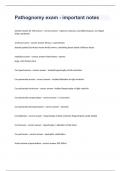
-
Pathoantomy exam - Important Notes Study Guide.
- Exam (elaborations) • 18 pages • 2024
-
Available in package deal
-
- $13.99
- + learn more
Pathoantomy exam - Important Notes Study Guide. Genetic factors for CNS tumors - correct answer - tuberous sclerosis, neurofibromatosis, von hippel lindau syndrome scirrhous tumor - correct answer Stroma > parenchyme densely packed (scirrhous means hard) tumors, containing dense bands of fibrous tissue medullary tumor - correct answer Parenchyme > stroma large, soft, fleshy tumor Cor hypertonicum - correct answer - isolated hypertrophy of left ventricles Cor pulmonale acutum...
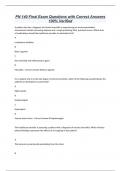
-
PN 140 Final Exam Questions with Correct Answers 100% Verified
- Exam (elaborations) • 34 pages • 2024
- Available in package deal
-
- $10.99
- + learn more
PN 140 Final Exam Questions with Correct Answers 100% Verified A patient who has a diagnosis of chronic bronchitis is experiencing an acute exacerbation. Assessments include increasing dyspnea and a cough producing thick, purulent mucus. Which class of medications should the healthcare provider to administer first? A Leukotriene inhibitor B Beta-2 agonist C Non-steroidal anti-inflammatory agent D Mucolytic - Correct Answer B Beta-2 agonist For a patient who is in the late stages of c...
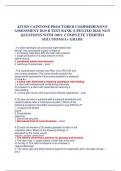
-
ATI RN CAPSTONE PROCTORED COMPREHENSIVE ASSESSMENT 2019 B TEST BANK (UPDATED 2024) NGN QUESTIONS WITH 100% COMPLETE VERIFIED SOLUTIONS/A+ GRADE
- Exam (elaborations) • 64 pages • 2024
-
- $15.99
- + learn more
ATI RN CAPSTONE PROCTORED COMPREHENSIVE ASSESSMENT 2019 B TEST BANK (UPDATED 2024) NGN QUESTIONS WITH 100% COMPLETE VERIFIED SOLUTIONS/A+ GRADE . If a client develops cor pulmonale (right-sided heart failure), the nurse would expect to observe 1. increasing respiratory difficulty seen with exertion. 2. cough productive of a large amount of thick, yellow mucus. 3. peripheral edema and anorexia. 4. twitching of extremities. - ans3 . The nursing team includes two RNs, one LPN/LVN, and on...
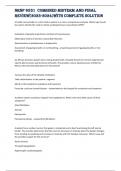
-
NRNP 6531 Combined midterm and final review(2023-2024)with complete solution A health care provider in a clinic finds a patient in a room, unresponsive and pale. Which sign should be used to identify the need to initiate cardiopulmonary resuscitation (CPR
- Exam (elaborations) • 209 pages • 2023
-
Available in package deal
-
- $12.99
- + learn more
NRNP 6531 Combined midterm and final review()with complete solution A health care provider in a clinic finds a patient in a room, unresponsive and pale. Which sign should be used to identify the need to initiate cardiopulmonary resuscitation (CPR)? Evaluation of peripheral perfusion and level of consciousness Obtaining a history of previous myocardial infarction Determination of pulselessness or bradycardia Assessment of gasping breaths or not breathing - answerAssessment of gasping breath...
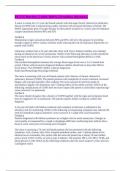
-
PCCN Review || with 100% Errorless Answers.
- Exam (elaborations) • 21 pages • 2024
-
Available in package deal
-
- $13.49
- + learn more
A nurse is caring for a 71-year-old female patient with end-stage chronic obstructive pulmonary disease (COPD) who is experiencing cardiac ischemia with increased shortness of breath. The MOST appropriate goal of oxygen therapy for this patient would be to: correct answers Maintain oxygen saturations between 90% and 92% Feedback Maintaining oxygen saturations between 90% and 92% will serve the purpose of providing enough oxygen to relieve cardiac ischemia while reducing the risk of respirato...
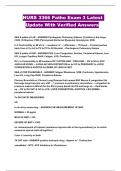
-
NURS 3366 Patho Exam 3 Latest Update With Verified Answers
- Exam (elaborations) • 12 pages • 2023
- Available in package deal
-
- $9.99
- 1x sold
- + learn more
NURS 3366 Patho Exam 3 Latest Update With Verified Answers...
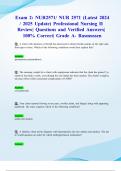
-
Exam 2: NUR2571/ NUR 2571 (Latest 2024/ 2025 Update) Professional Nursing II Review| Questions and Verified Answers| 100% Correct| Grade A- Rasmussen
- Exam (elaborations) • 15 pages • 2024
-
Available in package deal
-
- $10.99
- + learn more
Exam 2: NUR2571/ NUR 2571 (Latest 2024/ 2025 Update) Professional Nursing II Review| Questions and Verified Answers| 100% Correct| Grade A- Rasmussen Q: A client with shortness of breath has decreased to absent breath sounds on the right side, from apex to base. Which of the following conditions would best explain this? Answer: spontaneous pneumothorax Q: The morning weight for a client with emphysema indicates that the client has gained 5 pounds in less than a week, even though ...
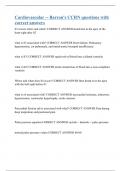
-
Cardiovascular -- Barron's CCRN questions with correct answers
- Exam (elaborations) • 26 pages • 2023
- Available in package deal
-
- $14.99
- + learn more
S3 occurs where and when? CORRECT ANSWER heard best at the apex of the heart right after S2 what is S3 associated with? CORRECT ANSWER Heart failure, Pulmonary hypertension, cor pulmonale, and mitral/aortic/tricuspid insufficiency what is S3? CORRECT ANSWER rapid rush of blood into a dilated ventricle what is S4? CORRECT ANSWER atrial constriction of blood into a non-compliant ventricle Where and when does S4 occur? CORRECT ANSWER Best heard over the apex with the bell right before S...
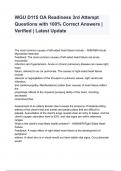
-
WGU D115 OA Readiness 3rd Attempt Questions with 100% Correct Answers | Verified | Latest Update
- Exam (elaborations) • 19 pages • 2024
- Available in package deal
-
- $7.99
- + learn more
WGU D115 OA Readiness 3rd Attempt Questions with 100% Correct Answers | Verified | Latest Update The most common causes of left-sided heart failure include: - ANSWER-Acute Myocardial Infarction Feedback: The most common causes of left-sided heart failure are acute myocardial infarction and hypertension. Acute or chronic pulmonary disease can cause right heart failure, referred to as cor pulmonale. The causes of right-sided heart failure include stenosis or reg

How did he do that? By selling his study resources on Stuvia. Try it yourself! Discover all about earning on Stuvia


